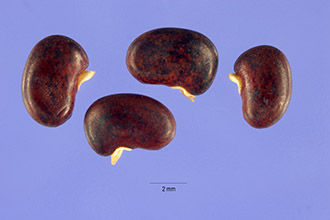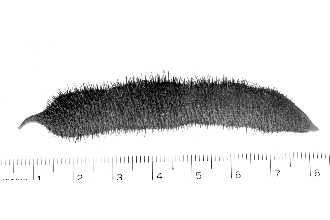Robinia fertilis Ashe
Scientific Name: Robinia fertilis Ashe

| General Information | |
|---|---|
| Usda Symbol | ROFE3 |
| Group | Dicot |
| Life Cycle | Perennial |
| Growth Habits | ShrubTree, |
| Native Locations | ROFE3 |
Plant Guide
Use soil moisture sensors to measure the soil moisture of Robinia fertilis Ashe.
Fact Sheet
Alternate Names
Robinia fertilis Ashe, Robinia grandiflora Ashe, Robina pedunculata Ashe
Uses
Bristly locust is perhaps the best erosion control shrub for steep sloping sites with active erosion. It provides quick, woody, vegetative cover on droughty, critical areas needing stabilizing cover. It is useful for vegetating acid soils with a pH of 3.5 to 4.0, as well as alkaline soils of a pH 8.0. Bristly locust is especially adapted to stabilizing soils with active rill and gully erosion. Rill erosion that exposes the roots stimulates root suckering there by creating a denser growth. Bristly locust is primarily used for surface mine spoil reclamation, industrial waste piles, roadbanks, cuts and fills, etc. In comparison with most other shrubs it will excel in seedling vigor. It has the ability to fix nitrogen in the soil, and with light shade it does not inhibit growth of annual and perennial herbs. Its value for wildlife food is minimal, but is a very attractive shrub when in bloom. It should not be used for residential plantings, or anywhere that formal landscaping is desired. Bristly locust is used by the Maine Department of Transportation as living fence along major highways. The stems trap snow, improving public safety. Bristly locust winterkills above the snow line in USDA Hardiness Zones 4 and 3, which keeps the growth in check.
Status
Please consult the PLANTS Web site and your State Department of Natural Resources for this plant’s current status (e.g. threatened or endangered species, state noxious status, and wetland indicator values).
Description
Bristly locust is an open branched, straggly, woody legume of vigorous growth, Use soil moisture sensors to measure the soil moisture of Robinia fertilis Ashe., It attains a height of 8 to 12 feet in a few years, but normally when planted on critical sites it will grow no taller than 6 to 7 feet, It spreads rapidly on some sites by root suckers, particularly those soils light in texture, Where herbaceous plants are dense, spreading is severely restricted, Spreading by seed is secondary to root suckers, There are 23,000 seeds per pound, Charles B, Ford Upper Darby, PA Numerous small leaflets comprise the compound leaf that occurs alternately on the bristle covered branches, The sweet pea-like rose colored flowers bloom in May and June, Flowering usually begins the second year, Seed is produced in the bristle covered pods that are 2 to 5 inches in length, Seeds are about 3/16 inch in size, dark brown, and very hard, Root suckers may appear the first year, and the thicket forming growth habit will begin by the second year, Leaf litter accumulates early, and is held in place by the many small stems that develop from the roots,
Adaptation and Distribution
Distribution
Distribution
Bristly locust will grow throughout the Northeast. In the northern sections of Maine, New Hampshire, Vermont, and New York it may winterkill above the snow. Bristly locust grows best on silt loams and loamy soils with good drainage; however, it will tolerate soils that are moderately well drained. It will grow on acid soils as low as pH 3.5 but it thrives at a pH of 6.0 to 7.0. For a current distribution map, please consult the Plant Profile page for this species on the PLANTS Website.
Establishment
Follow standard tree planting techniques. Planting stock should be 1 year old seedlings. Prepare holes large enough to take care of entire root system. Fertilizer is not required. Bristly locust responds to fertilizers high in phosphorous, such as Mag-Amp, particularly on acid sites.
Plant Traits
Growth Requirements
| Temperature, Minimum (°F) | -30 |
|---|---|
| Adapted to Coarse Textured Soils | Yes |
| Adapted to Fine Textured Soils | No |
| Adapted to Medium Textured Soils | Yes |
| Anaerobic Tolerance | None |
| CaCO3 Tolerance | Medium |
| Cold Stratification Required | No |
| Drought Tolerance | High |
| Fertility Requirement | Low |
| Fire Tolerance | Medium |
| Frost Free Days, Minimum | 160 |
| Hedge Tolerance | None |
| Moisture Use | Low |
| pH, Maximum | 7.5 |
| pH, Minimum | 3.5 |
| Planting Density per Acre, Maxim | 4800 |
| Planting Density per Acre, Minim | 1200 |
| Precipitation, Maximum | 60 |
| Precipitation, Minimum | 32 |
| Root Depth, Minimum (inches) | 20 |
| Salinity Tolerance | None |
| Shade Tolerance | Intolerant |
Morphology/Physiology
| Bloat | None |
|---|---|
| Toxicity | None |
| Resprout Ability | Yes |
| Shape and Orientation | Erect |
| Active Growth Period | Spring and Summer |
| C:N Ratio | High |
| Coppice Potential | No |
| Fall Conspicuous | No |
| Fire Resistant | No |
| Flower Color | Purple |
| Flower Conspicuous | No |
| Foliage Color | Green |
| Foliage Porosity Summer | Moderate |
| Foliage Porosity Winter | Porous |
| Foliage Texture | Coarse |
| Fruit/Seed Conspicuous | No |
| Nitrogen Fixation | High |
| Low Growing Grass | No |
| Lifespan | Moderate |
| Leaf Retention | No |
| Known Allelopath | No |
| Height, Mature (feet) | 7.0 |
| Height at 20 Years, Maximum (fee | 7 |
| Growth Rate | Rapid |
| Growth Form | Rhizomatous |
| Fruit/Seed Color | Black |
Reproduction
| Vegetative Spread Rate | Rapid |
|---|---|
| Small Grain | No |
| Seedling Vigor | High |
| Seed Spread Rate | None |
| Fruit/Seed Period End | Fall |
| Seed per Pound | 27700 |
| Propagated by Tubers | No |
| Propagated by Sprigs | No |
| Propagated by Sod | No |
| Propagated by Seed | Yes |
| Propagated by Corm | No |
| Propagated by Container | Yes |
| Propagated by Bulb | No |
| Propagated by Bare Root | Yes |
| Fruit/Seed Persistence | Yes |
| Fruit/Seed Period Begin | Summer |
| Fruit/Seed Abundance | High |
| Commercial Availability | Routinely Available |
| Bloom Period | Late Spring |
| Propagated by Cuttings | No |
Suitability/Use
| Veneer Product | No |
|---|---|
| Pulpwood Product | No |
| Post Product | No |
| Palatable Human | No |
| Palatable Graze Animal | Low |
| Palatable Browse Animal | Low |
| Nursery Stock Product | Yes |
| Naval Store Product | No |
| Lumber Product | No |
| Fodder Product | No |
| Christmas Tree Product | No |
| Berry/Nut/Seed Product | No |

